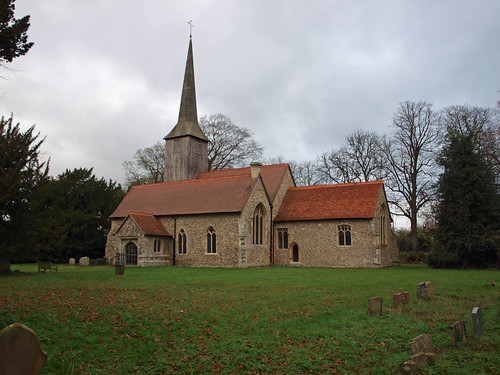St Andrew was locked with no sign of a keyholder perhaps not surprisingly since Good Easter is small, in fact the church seems too large for the village. I found this a pleasing church with its needle spire, quirky design and tree surrounded churchyard.
UPDATE: I found out recently that it is open from April to October so revisited [07.08.15] and found a dull interior with little of interest. Why a church should only be kept open in spring/summer months eludes me but I'm sure there are good ecclesiastical reasons.
UPDATE: I found out recently that it is open from April to October so revisited [07.08.15] and found a dull interior with little of interest. Why a church should only be kept open in spring/summer months eludes me but I'm sure there are good ecclesiastical reasons.
A small flint and stone rubble church of Norman foundation. The nave is circa 1200. The chancel is of the C13 and was lengthened circa 1230 at the time the chancel arch was built. The south aisle was rebuilt and widened in the early C14. The south porch is of the C15. In 1885 the west end was severely damaged by fire and was largely rebuilt when the church was restored in 1886. There is a small bell turret with vertical boarding and a slender octagonal shingled broach spire. The chancel has wall arcading of 4 and 5 bays with a stone bench below (the north side is wood covered) and a moulded string course above. (Circa 1230 ). In the nave there are 2 blank half arches on each side of the chancel arch (also circa 1230). The north door is renewed but has the original lock and key. The roofs are tiled.
ST ANDREW. Nave and chancel; belfry with vertical weatherboarding and a tall thin shingled spire. The belfry rests on four posts with arched braces to the E and W as well as the N and S. The nave is of the C13, the chancel also, but a little later. The evidence is not easily understood. Early C13 W window, original internally. In the E wall two blank half arches of the same date. They must at first, in their complete form, have flanked a narrower, probably Norman chancel. Then the chancel was rebuilt and widened. That also, on the evidence of the Sedilia and Piscina, cannot have been later than c. 1240. The Piscina has typical shafts, the Sedilia and some blank wall arcading on the N side of the chancel has an odd alternation of arches continued below without any capitals, and arches carried on capitals ending in (Cistercian) corbels instead of shafts. The S arcade is a little later, c. 1300 or so. One circular and one octagonal shaft, moulded capitals and only slightly double-chamfered arches. The westernmost pier is the same but the arches are properly double-chamfered - perhaps a later repair. - STAINED GLASS. Bits of the C14 and C15 in two S aisle windows. - HELM. Probably late C16; chancel N wall. - BRASS of 1610.
ST ANDREW. Nave and chancel; belfry with vertical weatherboarding and a tall thin shingled spire. The belfry rests on four posts with arched braces to the E and W as well as the N and S. The nave is of the C13, the chancel also, but a little later. The evidence is not easily understood. Early C13 W window, original internally. In the E wall two blank half arches of the same date. They must at first, in their complete form, have flanked a narrower, probably Norman chancel. Then the chancel was rebuilt and widened. That also, on the evidence of the Sedilia and Piscina, cannot have been later than c. 1240. The Piscina has typical shafts, the Sedilia and some blank wall arcading on the N side of the chancel has an odd alternation of arches continued below without any capitals, and arches carried on capitals ending in (Cistercian) corbels instead of shafts. The S arcade is a little later, c. 1300 or so. One circular and one octagonal shaft, moulded capitals and only slightly double-chamfered arches. The westernmost pier is the same but the arches are properly double-chamfered - perhaps a later repair. - STAINED GLASS. Bits of the C14 and C15 in two S aisle windows. - HELM. Probably late C16; chancel N wall. - BRASS of 1610.
GOOD EASTER. A timber spire, soaring above the trees 100 feet high points the way to this delightful old-world place in the valley of the River Can. It may be proud of its past history, for in the Middle Ages it belonged to St Martin’s-le-Grand, and Henry the Eighth gave it to Westminster Abbey. The have and the chancel are 13th century, and the aisle with its line arcade is from the 14th. An unusual feature of the chancel is the stone bench under the arcades along each wall. Among the small treasures of the church are a carved chair of Cromwell’s time, a tiny coffin lid of the 13th century, and (not so small) an old bassoon used in the choir 100 years ago. High on the wall above, resting on a corbel, is a dog's head with its tongue lolling out, the crest of the owner of the 16th century helmet above it. Margaret Norrington, whose brass is in the aisle, may have seen this great man’s funeral.
On the patch of green by the church is the old whipping-post.

No comments:
Post a Comment